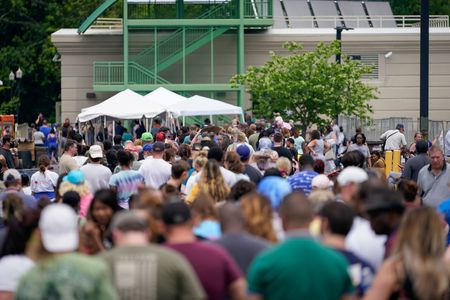By Howard Schneider
WASHINGTON (Reuters) – A continued drop in job openings and a dip in the rate at which workers are quitting have kept alive, for now, a key Federal Reserve narrative that the economy can slow without a major crack in employment.
New data for March showed the ratio of job openings to the number of unemployed job seekers fell for the fourth consecutive month and hit the lowest level since October 2021.
The statistic is one watched closely by Fed Chair Jerome Powell for evidence the tightly stretched U.S. labor market is moving back to normal – and it may be starting to deliver.
At roughly 1.64 to 1 the number remains far above the levels around 1.2 seen before the pandemic.
(Graphic: Unemployed to job openings – https://www.reuters.com/graphics/USA-FED/JOBS/egvbkmeoepq/chart.png)
But when the Fed began raising interest rates a year ago the number was above 2, and stayed near there for months before beginning what has been a steady decline since the fall – largely due to a drop in the estimated number of job openings. The number of unemployed, which can be influenced both by people beginning a job search – a positive economic development – as well as by job losses, remains below where it was when the Fed started hiking rates in March of 2022.
“The signs of labor market softness won’t be a game-changer for tomorrow’s (Federal Open Market Committee) meeting,” JP Morgan economist Michael Feroli wrote after the release of the latest Job Openings and Labor Turnover Survey. But “they do suggest that the cumulative amount of policy tightening is starting to have its desired effect on businesses’ labor demand.”
The Fed is expected to raise its benchmark policy rate on Wednesday by another quarter of a point, to a range of between 5% and 5.25%, as it tries to curb inflation that is still running at more than double its 2% target.
BEVERIDGE CURVE
Higher interest rates should curb household and business spending and lower the pace of price increases as well.
As the economy slows, Fed officials do anticipate the unemployment rate to rise – indeed Powell and others have said the U.S. labor market needs to soften somewhat for inflation to fall.
But by how much remains a subject of debate, with some policymakers, particularly Fed Governor Christopher Waller, arguing that some of the tension in the job market could be relieved through a decline in job openings without much rise in the unemployment rate.
In recent months the relationship between job openings and unemployment has kept that prospect alive.
The number of estimated job openings has fallen from a peak of 12 million in March of 2022 to 9.59 million in March this year.
The openings rate, expressed as a percentage of filled and available positions, has fallen from a high of 7.4 last spring to 5.8 in March. The unemployment rate, meanwhile, has remained lodged around 3.5% – pushing what’s known as the “Beveridge Curve” steadily back towards where it was before the pandemic, a sign of normalization Waller has felt could mute the impact of the Fed’s inflation fight on joblessness.
(Graphic: A shift in the Beveridge Curve? – https://www.reuters.com/graphics/USA-FED/JOBS/zgpomomzqpd/chart.png)
Job and unemployment data for April will be released this Friday, with economists polled by Reuters expecting job gains slowing to around 179,000, more akin to levels seen before the pandemic, with the unemployment rate rising to 3.6%.
Other aspects of the JOLTS reported pointed to some cooling. Layoffs jumped among construction workers, following the slowdown in the housing sector. And the rate at which workers are quitting jobs fell to a two-year low – a fact economists say may help pull down the pace of wage increases driven higher by worker’s ability to job-hop for higher pay.
(Reporting by Howard Schneider; Editing by Dan Burns and Andrea Ricci)





